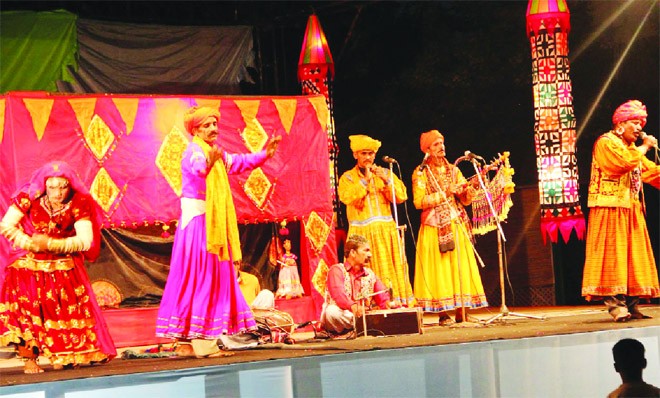

Since the just-concluded National Folk Puppet Festival in Lahore was the eleventh in a row, the tradition of holding such festivals has become firmly rooted now. It should come as no surprise as the Rafi Peer Theatre Workshop (RPTW), through its ceaseless effort, has been principally responsible in bringing this fringe puppetry into mainstream culture over the past few decades.
The RPTW has actively promoted culture and arts, both at home and abroad, for over 36 years, with over 50 festivals of performing arts. Millions of people have attended these festivals to watch 30,000 performers from around the world.
This year, the festival was held more in the atmosphere of a mela. A traditional mela has so much more than just one activity. It has music, dance and various other forms of amusements, including a lot to eat and pick on particularly for children.
This festival, too, despite the location which has sprung up recently, generated the atmosphere of bonhomie. The idea was to offer relaxation and entertainment, and so many folk artistes pitched in with their music numbers as well.
The most outstanding was Krishan Lal Bheel. His colourful attire and pleasant looking and sweet sounding instruments were an instant draw for the children. They loved his singing and dancing, and it went well with the ambience of the mela, where the principal hue of the desert was maintained. The vast stretches of Rajasthan and Cholistan have preserved and nurtured the art of traditional puppetry all these centuries.
Special arrangements were made to transport children to the festival. Many schools cooperated and thousands of children from a variety of schools were a part of the festival. Usually children are denied these opportunities because of the responsibility attached to their transportation and security. But the arrangement with the schools made it possible for them to be part of the activity during school hours.
The morning session that started at 9am usually was full with schoolchildren. The second session, in the afternoon and evening, attracted people of all ages.
About 60 odd years ago, a revolution took place in puppetry when Jim Hansen’s programme Sesame Street became a popular show on television. It went on to break many barriers and established new frontiers -- the least being that it inspired puppeteers from all over the world to take a fresh interest in puppetry by bringing in greater innovation and experiment. Akar Bakar was started by Shoaib Hashmi on Pakistan Television and that set the precedent for many others including the National Puppet Group under the Pakistan National Council of the Arts and, a little later, the Alhamra Puppet Group to take puppetry more seriously.
Farooq Qaiser alias Uncle Sargam became almost a permanent fixture that was topical, biting in its satire and uproariously funny. It had a following that transcended age and language. It was one of the most popular shows in the country and ran for years without a break.
When the first International Puppet Festival was held in 1992, the wider possibility of the form became apparent to everyone. It was not only the content that was varied, the various forms of puppetry and the intermixing of actors with puppets was truly fascinating. It broke down the divide that had traditionally existed between actors and puppets.
But all that is history now. The various stages that have been crossed have been due to the Rafi Peer Theatre Workshop and the untiring effort of the group.
The traditional puppets here have been the string puppets and this patent craft has travelled down generations, specialised by the gypsies from Rajasthan. They have their own stories, like the epic battle that was fought between Dulla Bhatti and Akbar the Great and a whole range of characters that grew round it to represent the funny and pompous side of managing the affairs of empires and men.
Pattey Khan and Gauhar Jan too have been stock characters who may have changed their roles as the oral tradition encountered the challenges of meeting contemporaneity over generations.
When the festival was being planned, the foremost idea was the preservation of the traditional art of puppetry in this part of the world. Due to other forms of entertainment, films, television and now the apps and mobiles, many more of the traditional arts like the marionette are under threat. It is disappearing as its practitioners are not been replaced by just as many, if no more. A few have lived on the fringes of cities waiting for their turn to be invited.
The festivals and the establishment of the Puppet Museum have made a difference to the activities of these traditional puppeteers but much needs to be done even now.
Asghar from Bahawalpur, Mohammad Bashir from Multan, M. Nadeem, Mohammad Ali and M. Shahid from Multan, Yasin and Aziz from Khanewal, M. Ashiq from Lodhran and Durwaish from Dunyapur, National Puppet Theatre from PNCA, Islamabad, Alhamra Puppet Theatre from Lahore Arts Council took part in the festival.
The objective of the festival, to promote the traditional folk arts and help performers from all the provinces of Pakistan, has resulted in creating work opportunities for the local artistes and their families, and has encouraged them to stick with their art form and techniques.